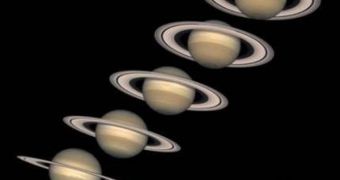Tomorrow, August 11, the planet Saturn will perform one of the most amazing “magic” tricks ever seen in the solar system, as it will make its enormous rings, comprised of trillions of trillions of ice and dust, simply vanish and not show on any telescopes. All it needs to do this is the correct sunlight, plus a set of rings only 30 feet in thickness. The magic act takes place once every 15 years, during the planet's biannual equinox, ScienceDaily informs.
“Saturn has been performing the 'ring plane crossing' illusion about every 15 years since the rings formed, perhaps as long as 4.5 billion years ago, so by now it is pretty good at it. The magician's tools required to perform this trick are pure sunlight, a planet that wobbles, and a main ring system that may be almost 200-thousand miles wide, but only 30 feet thick,” adds NASA Jet Propulsion Laboratory (JPL) expert Linda Spilker, from Pasadena, California. She is the Cassini Saturn mission deputy project investigator. “Whenever equinox occurs on Saturn, sunlight will hit Saturn's thin rings, the ring plane, edge-on. The light reflecting off this extremely narrow band is so small that for all intents and purposes the rings simply vanish,” the scientist adds.
Considering that the Earth needs one year to move around the Sun once, it takes approximately 29 years for Saturn to move around the star once, on account of the fact that its orbit is much further away than ours. And, while on Earth, equinoxes occur twice yearly, in mid-March and mid-September, on Saturn, they occur once every 15 earthy years, or twice per year in its own time frame. “While we know how Saturn pulls off its ring-plane crossing illusion, we are still fascinated and mystified by Saturn's rings, and equinox is a great time for us to learn more,” Spilker says, adding that even Galileo was puzzled by the rings' (which he thought were moons) disappearance act.
Fortunately for astronomers today, they no longer have to relay solely on ground- or orbit-based telescopes for their studies. They have the Cassini spacecraft in the first row on Saturn's “stage.” The probe, which has been orbiting the planet for the last five years, is in the ideal position to observe all new moons and moonlets that may become visible during the equinox.
The Cassini-Huygens mission is a cooperative project of NASA, the European Space Agency (ESA) and the Italian Space Agency. The Cassini orbiter was designed, developed and assembled at JPL. The laboratory manages the mission for the Science Mission Directorate at NASA Headquarters, in Washington DC.

 14 DAY TRIAL //
14 DAY TRIAL //